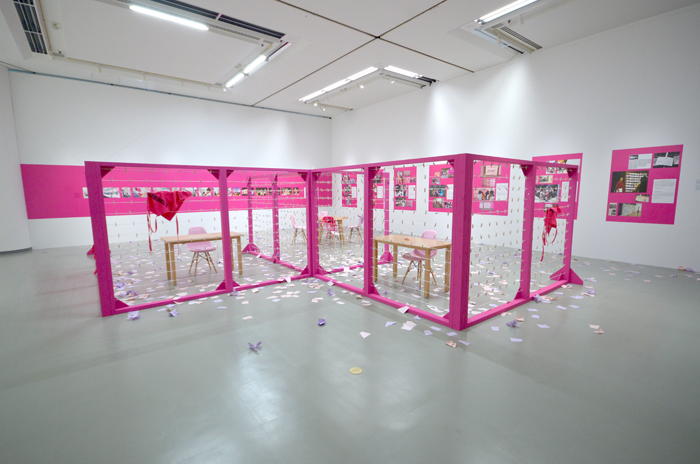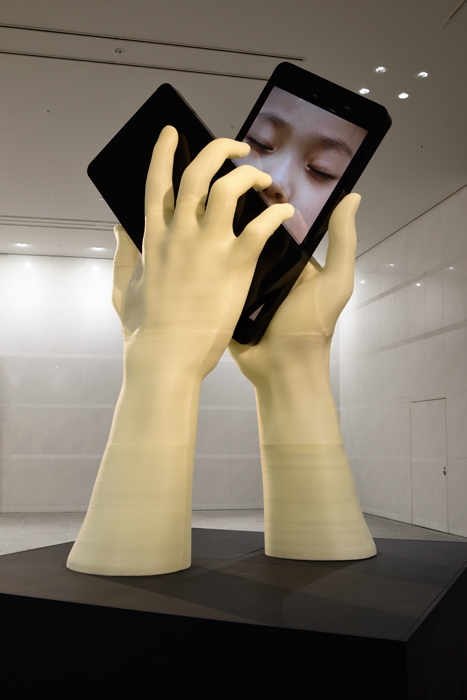That old adage about the quiet type being the most dangerous type came to mind during the tragicomic opening days of the fourth Aichi Triennale. Before it had even begun, rightwing sections of the Japanese media were questioning the inclusion of Kim Seo-kyung and Kim Eun-sung’s lifesize statue of a so-called comfort woman (Statue of Peace, 2011), an unassuming tribute to the Korean victims of Japanese military sex-slavery before and during the Second World War. On day three, the official denouncements and terrorist threats resulting from the presence of the taciturn girl with fists clenched led to the closure of After ‘Freedom of Expression?’, a micro-exhibition within the main exhibition made up of works recently censored or deemed taboo in Japan. By week three, 11 additional artists had withdrawn or altered their own work in solidarity.
Conservative outrage and historical revisionists: one; reasoned debate and sanctity of the art object: nil. Or perhaps not. Media-activist-turned-artistic-director Daisuke Tsuda, his five curators and 90 artists were rightly dismayed at the knee-jerk closure, but the on-the-ground reality is that this full-blooded triennale has not been disproportionately vandalised by it. Indeed, if, as Tsuda explained, it is designed to flow and feel like a magazine, then After ‘Freedom of Expression?’ was always a bonus pullout section: arguably superfluous, deliciously incendiary. Moreover, the rest of Taming Y/Our Passion – an issues-based festival that seeks to address, ironically it now seems, ‘the sensationalisation of media that at present plagues and polarises people around the world’ and ‘to speak to our compassion’ in the hope of ‘solving this predicament’ – plays the role of mature intermediary more persuasively. In service of this right-on mission, it smartly exploits the semantic ambiguities of the Japanese title 情の時代 (情, or jō in kanji, can apparently mean emotion, information or compassion, none of which are in short supply here), and in contrast to the 2016 edition, which celebrated the creativity and manufacturing industry of Aichi Prefecture, traffics mainly in hard realities, not reveries.
At the main venues, the Aichi Arts Center and Nagoya City Art Museum, the feel is more scrapbook than neatly edited magazine, but in a good way. Themes and mediums are circuitously explored, looped around. So it is that you might find yourself deflecting the suave advances of Dora Garcia’s dishy male interlopers (The Romeos, 2019) while admiring exonemo’s posthumanist sculpture of two screens kissing (The Kiss, 2019). Or kneeling down to survey the unearthly terrain of Imamura Yohei’s scale model-like sculpture made from repeating the silkscreen printing process thousands upon thousands of times (tsurugi No.1, 2016) one minute, gazing up at Yuan Goang-Ming’s drone footage of deserted Taipei streets during the annual martial law drill (Everyday Maneuver, 2018; suspended as of writing) the next.
A fair proportion of works, such as Ugo Rondinone’s Vocabulary of Solitude (2014–16), a room filled with 45 contemplative clowns squatting, lying or kneeling, pair a showstopping scale with a terse punchline. Another is Takamine Tadasu’s Anti-thesis: Gazing up at the endless blue // stained forever by its color // I have ceased to be myself (2019), for which a section of an old swimming pool located near the Toyota Municipal Museum of Art has been flipped 90 degrees skyward.
Cutting deeper are the works I can imagine Tsuda and his team classifying as of the cutout-and-keep variety: research-driven multidisciplinary projects that either already have a life beyond the festival or, failing that, have the potential to achieve it. In addition to well-travelled series, such as Taryn Simon’s Paperwork and the Will of Capital (2015) – photographs of impossible floral centrepieces paired with political accords, contracts, treaties and decrees – new ones in this ruminative vein include a roomful of letters, Psicomagia (2019), relating to a form of let-it-all-out psychotherapy developed by Chilean filmmaker Alejandro Jodorowsky and his wife, artist Pascale Montandon-Jodorowsky.

Other new commissions tease out the topical dichotomies that are this staunchly left-leaning triennale’s bread and butter: discrimination and tolerance, machines and humans, collective memory and amnesia. Among them, Koki Tanaka’s Abstracted / Family (2019) explores the suburban milieu and misgivings of mixed-race Japanese families through abstract paintings, family photos, documentary and notes. And Ho Tzu Nyen’s Hotel Aporia (2019) tackles the anguish of unresolved history in a more lyrical manner than the didactic and hectoring After ‘Freedom of Expression?’ section. Projected on walls and screens in a late Meiji-period inn over in Toyota City, his phantasmagoric video shorts comprise Yasujiro Ozu movie-clips that indirectly touch on war, and feature faces smoothed out to a searing nothingness.
Back at the Aichi Arts Center, the implications of cutting-edge tech – a pertinent topic for a nation with an ageing population and a bad case of Galápagos syndrome – are broached in Goro Murayama’s The portrait to Umwelts & Programs (2016), which juxtaposes photographs of people pulling funny faces that aren’t picked up by facial-recognition AI with paintings of abstracted facelike patterns that are; and Decoy Walking (2019), a TV studio setup that is intended to dupe gait detection software. A few rooms on, Heather Dewey-Hagborg’s chilling Stranger Visions (2012–13) is a series of 3D-printed faces, each hovering above cigarette butts, hairs or chewing gum – the New York street-trash from which DNA samples were scraped to create them.
This is a supple, stimulating triennial (other subthemes, such as Nagoya’s South American migrant communities, are circled around, and the separate film and performing-art strands are similarly piquant) shot through with Tsuda’s liberal sensibility: it strives, on paper at least, to challenge regressive conservatism and bigotry of all stripes. I salute his idealism, but given the rocky start and the allegations of censorship surfacing since, I must also wonder: will it end well? After ‘Freedom of Expression?’s closure may have succeeded at exposing the limits of freedom of expression in Japan, but on the other hand, trolling the country’s vociferous right wing and then capitulating to their demands (ostensibly on ‘risk management’ grounds) has backfired spectacularly.
How else can one square a situation whereby, for example, Mónica Mayer’s ongoing participatory project The Clothesline (1978–), a simple yet emancipatory work that invites visitors to write notes about their experience of sexual harassment or violence against women and pin them up for others to read, has been silenced until the shutdown is reversed? One of these anonymous messages, now torn up and tossed across the floor by Mayer in protest, unwittingly captures the demoralised tone that prevails in the messy aftermath of those miserable opening days: ‘Sometimes, in the street, when men have yelled at me, I wish I had gone back and confronted them. I have not done it out of FEAR.’
Aichi Triennale 2019: Taming Y/Our Passion, various venues, Nagoya & Toyota City, 1 August – 14 October 2019
From the Autumn 2019 issue of ArtReview Asia
